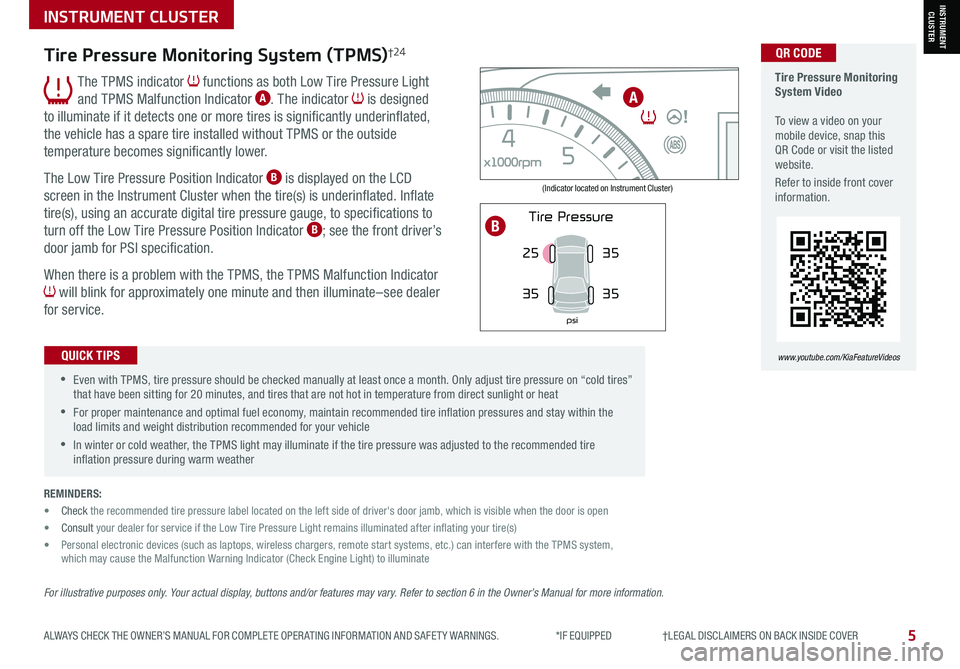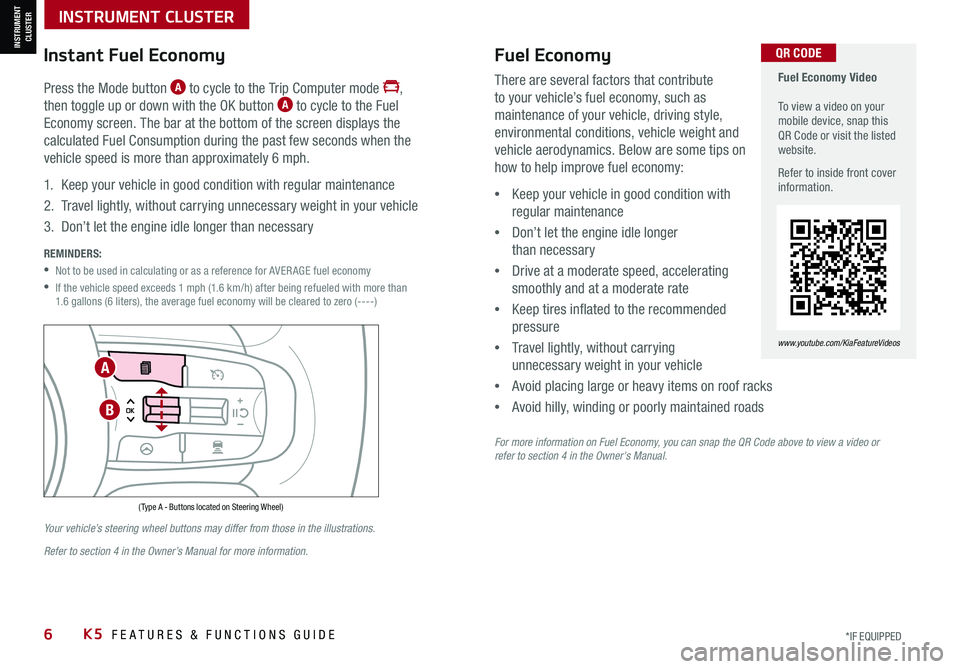flat tire KIA K5 2021 Features and Functions Guide
[x] Cancel search | Manufacturer: KIA, Model Year: 2021, Model line: K5, Model: KIA K5 2021Pages: 58, PDF Size: 4.9 MB
Page 7 of 58

0
20
40 60
80
100
120
140
160
180
200
220
240
260
0
1 2
3
4
5
6
7
8
km/h
EPB
C H
x1000rpm
0
20 40
60
80
100
120
1 40
1 60
E
F
MPH
Tire Pressure Monitoring System Video To view a video on your mobile device, snap this QR Code or visit the listed website.
Refer to inside front cover information.
www.youtube.com/KiaFeatureVideos
QR CODE
(Indicator located on Instrument Cluster)
Tire Pressure Monitoring System (TPMS)†24
The TPMS indicator functions as both Low Tire Pressure Light
and TPMS Malfunction Indicator A. The indicator is designed
to illuminate if it detects one or more tires is significantly underinflated,
the vehicle has a spare tire installed without TPMS or the outside
temperature becomes significantly lower.
The Low Tire Pressure Position Indicator B is displayed on the LCD
screen in the Instrument Cluster when the tire(s) is underinflated. Inflate
tire(s), using an accurate digital tire pressure gauge, to specifications to
turn off the Low Tire Pressure Position Indicator B; see the front driver’s
door jamb for PSI specification.
When there is a problem with the TPMS, the TPMS Malfunction Indicator
will blink for approximately one minute and then illuminate–see dealer
for service.
•Even with TPMS, tire pressure should be checked manually at least once a month. Only adjust tire pressure on “cold tires” that have been sitting for 20 minutes, and tires that are not hot in temperature from direct sunlight or heat
•For proper maintenance and optimal fuel economy, maintain recommended tire inflation pressures and stay within the load limits and weight distribution recommended for your vehicle
•In winter or cold weather, the TPMS light may illuminate if the tire pressure was adjusted to the recommended tire inflation pressure during warm weather
QUICK TIPS
REMINDERS:
• Check the recommended tire pressure label located on the left side of driver's door jamb, which is visible when the door is open
• Consult your dealer for service if the Low Tire Pressure Light remains illuminated after inflating your tire(s)
• Personal electronic devices (such as laptops, wireless chargers, remote start systems, etc.) can interfere with the TPMS system, which may cause the Malfunction Warning Indicator (Check Engine Light) to illuminate
For illustrative purposes only. Your actual display, buttons and/or features may vary. Refer to section 6 in the Owner’s Manual for more information.
5ALWAYS CHECK THE OWNER’S MANUAL FOR COMPLETE OPER ATING INFORMATION AND SAFET Y WARNINGS. *IF EQUIPPED †LEGAL DISCL AIMERS ON BACK INSIDE COVER
A
INSTRUMENT CLUSTER
INSTRUMENT CLUSTER
Tire Pressure
35
25
35
psi
35
B
Page 8 of 58

6*IF EQUIPPEDK5 FEATURES & FUNCTIONS GUIDE
INSTRUMENT CLUSTER
INSTRUMENT CLUSTER Fuel Economy Video To view a video on your mobile device, snap this QR Code or visit the listed website.
Refer to inside front cover information.
www.youtube.com/KiaFeatureVideos
QR CODE
( Type A - Buttons located on Steering Wheel)
Instant Fuel Economy
Press the Mode button A to cycle to the Trip Computer mode ,
then toggle up or down with the OK button A to cycle to the Fuel
Economy screen. The bar at the bottom of the screen displays the
calculated Fuel Consumption during the past few seconds when the
vehicle speed is more than approximately 6 mph.
1. Keep your vehicle in good condition with regular maintenance
2. Travel lightly, without carrying unnecessary weight in your vehicle
3. Don’t let the engine idle longer than necessary
REMINDERS:
•Not to be used in calculating or as a reference for AVER AGE fuel economy
•
If the vehicle speed exceeds 1 mph (1.6 km/h) after being refueled with more than 1.6 gallons (6 liters), the average fuel economy will be cleared to zero (----)
Your vehicle’s steering wheel buttons may differ from those in the illustrations.
Refer to section 4 in the Owner’s Manual for more information.
There are several factors that contribute
to your vehicle’s fuel economy, such as
maintenance of your vehicle, driving style,
environmental conditions, vehicle weight and
vehicle aerodynamics. Below are some tips on
how to help improve fuel economy:
•Keep your vehicle in good condition with
regular maintenance
•Don’t let the engine idle longer
than necessary
•Drive at a moderate speed, accelerating
smoothly and at a moderate rate
•Keep tires inflated to the recommended
pressure
•Travel lightly, without carrying
unnecessary weight in your vehicle
•Avoid placing large or heavy items on roof racks
•Avoid hilly, winding or poorly maintained roads
For more information on Fuel Economy, you can snap the QR Code above to view a video or refer to section 4 in the Owner's Manual.
Fuel Economy
B
A